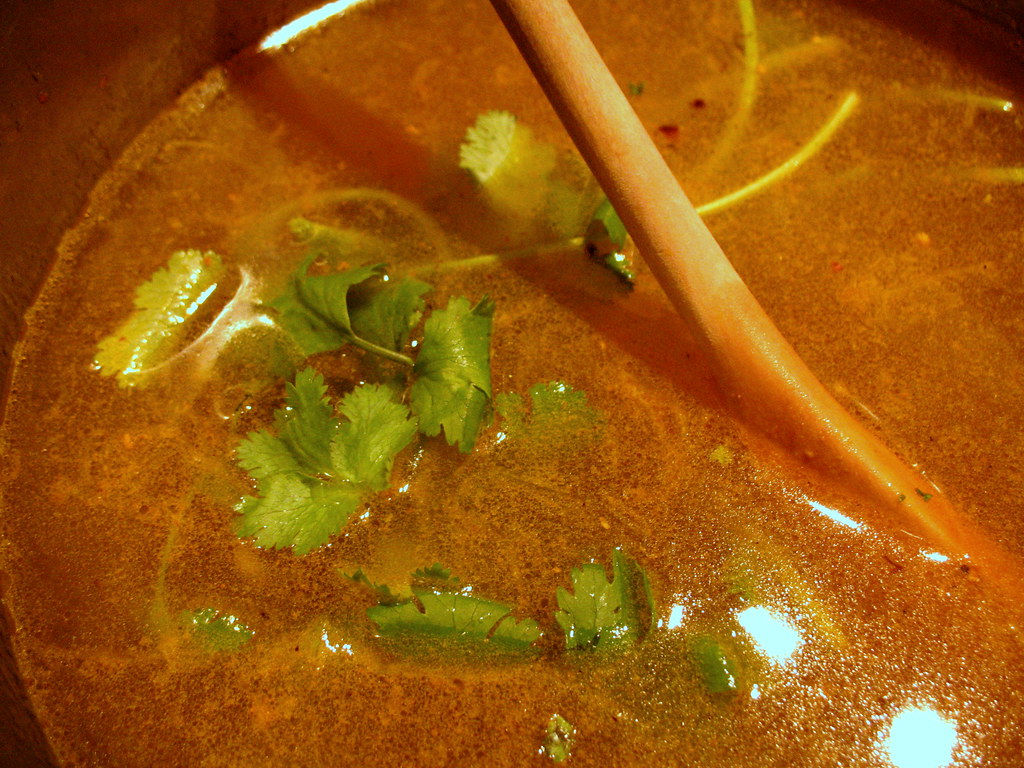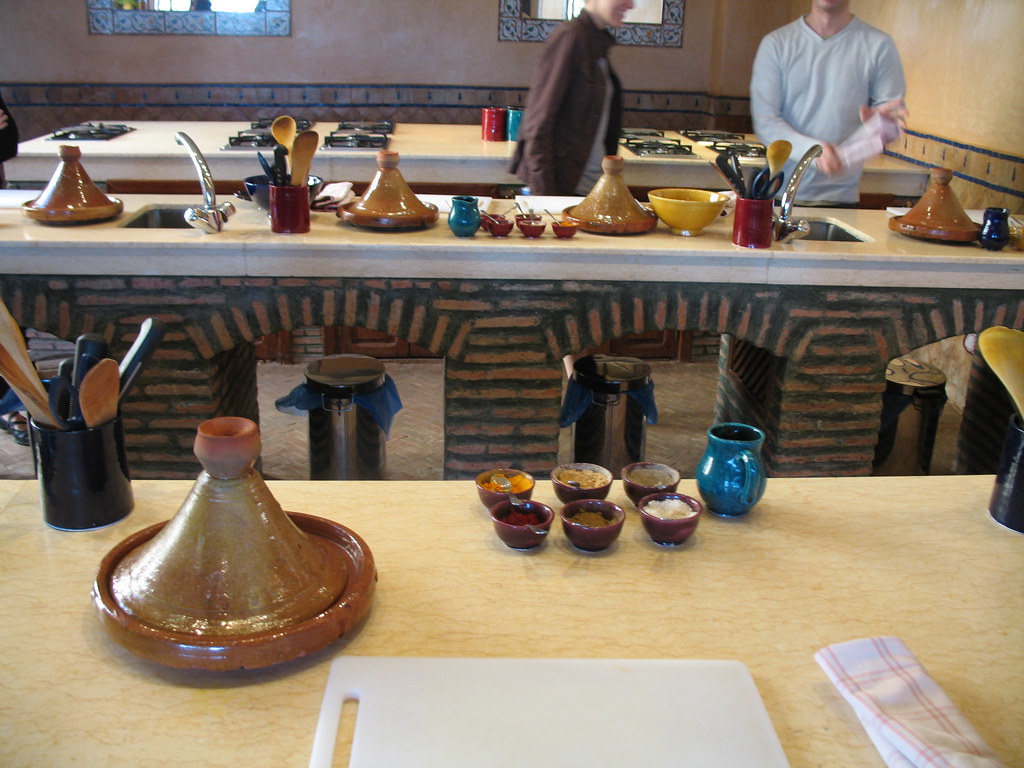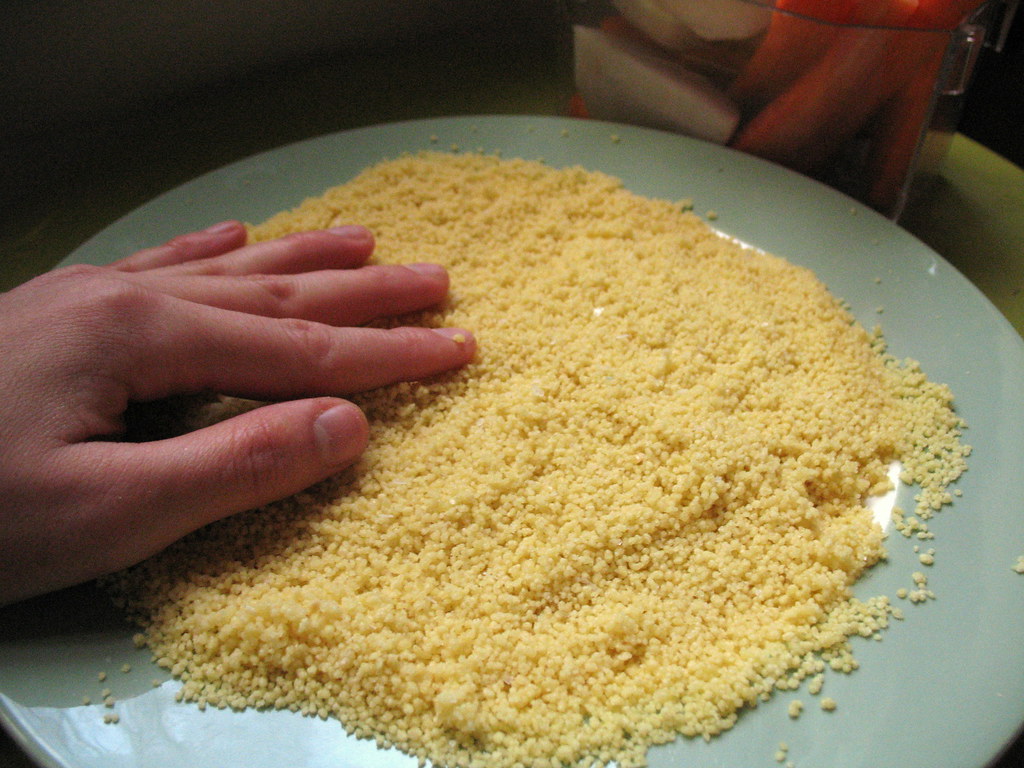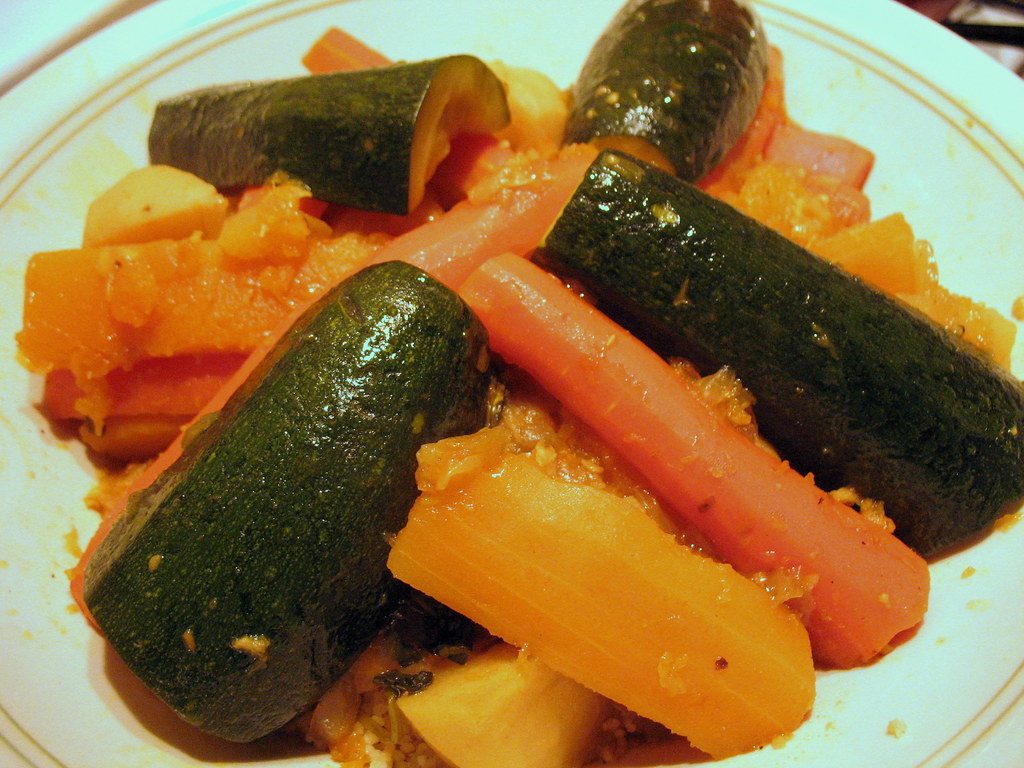
The first thing you’re probably wondering is why there is a big picture of broth instead of a completed, beautifully presented plate of winter vegetable couscous before us right now. That’s because when I made this at home, I erred on the side of caution and prepared the mostly winter dish with the addition of zucchini, just as I’d seen it done throughout my visit to Morocco. After eating mushy, limp zucchini several times there and then making it at home, however, I’ve concluded that this might not actually be necessary; the zucchini lends little to the savory vegetable broth that steams and flavors the couscous. It’s also not a winter vegetable — not here at least. And, like I said, it was soggy, mushy, limp and all but disappeared in your mouth.
The instructor of a cooking class I attended at La Maison Arabe guesthouse in Marrakesh told us that there are two distinct ways of preparing food in Moroccan cuisine: Fresh, fresh fresh, or cooked to death. The disparity is clear from their expertise in both hot and cold salads, as I got into a little in my first Marrakesh post. Cooking summer vegetables like zucchini to death somehow seemed bewildering to me at first; barely-cooked summer squash is a preference I must harbor as a Westerner and didn’t even realize. But then, cooking winter vegetables like hard, bitter turnips and coarse, mealy cabbage to a brothy oblivion seems right on cue. So that’s the formula I stuck with in this recipe, a slight variation on a classic vegetable couscous.
 my workstation at La Maison Arabe’s cooking class
my workstation at La Maison Arabe’s cooking class
Unconscious prejudices aside, Moroccan cuisine really has a handle on vegetarian dishes. I made this couscous along with several other Moroccan dips and simple salads last weekend for my uncle’s birthday — he is currently a vegetarian. Closely following the techniques that were described in the class, I simply left out any summer vegetables from this couscous. After all, it was definitely the squashes, turnips and carrots that really made the dish for me, and their different levels of sogginess was slightly fascinating. The butternut was sweet and really didn’t hold up too well. The carrots and parsnips were on the verge of crisp-tenderness. And the recipe yielded a good share of rich leftover vegetable broth, which turned out to be my mom and uncle’s favorite part.
 patience, repetition and unyielding TLC all goes into the couscous
patience, repetition and unyielding TLC all goes into the couscous
 no double boiler, but a colander-sur-stock pot did the trick
no double boiler, but a colander-sur-stock pot did the trick
Contrary to popular belief, traditional Moroccan couscous is not something that you just throw hot water on and sit back for five minutes until it’s “cooked.” The preparation takes a lot of time — about two and a half hours, our instructor warned — seasoning, and careful steps to create the delicate layers of flavor and fluffy texture that the best vegetable couscous dishes coyly provide.
 almost all-winter vegetable couscous
almost all-winter vegetable couscous
Winter Vegetable Couscous
(makes 3-4 servings)
1 cup uncooked couscous
1 medium red onion
2 large carrots, peeled and halved lengthwise
3 white turnips, peeled and quartered
1/2 lb butternut squash, peeled and cut to large chunks
2 large parsnips, peeled and halved lengthwise
1/2 lb pumpkin or acorn squash, peeled and cut to large chunks (optional)
1 small head of white cabbage, cut to large chunks (optional)
handful of fresh cilantro sprigs
1 tablespoon tomato paste
1 tablespoon turmeric
2 teaspoons grated fresh ginger (or powdered ginger)
2 teaspoons black pepper
2 teaspoons salt
3 tablespoons olive oil
In the bottom of a large double steamer (or stock pot as long as you have something that will suffice as a steamer rack that will fit on top), heat the olive oil. Add the finely sliced red onion, 1 teaspoon of salt, the black pepper, ginger and turmeric. Stir for 2 minutes on medium-high. Turn heat to medium-low and cover. Cook for another 10 minutes, stirring occasionally. Add the tomato paste and stir until well combined, then 3 cups of water and the coriander bunch (tied with kitchen string). Bring to a boil. Add the carrots, turnips, parsnips and cabbage (if using) to the broth. Cover and cook on low.
Meanwhile, spread the couscous on a large flat plate or platter. Add 1 teaspoon salt and 1 tablespoon of the olive oil. Mix in with hands. Add a tablespoon of cold water and mix with hands again. Let sit for 5 minutes. Gently rub couscous to break up any lumps. (These steps ensure that the couscous does not fall through the holes of the steamer rack.) Put couscous in the steamer rack or improvised version thereof, and continue to cook on low, uncovered for 25 minutes. Put couscous back onto the plate. Add the last tablespoon of olive oil and another tablespoon of water and mix again with your hands. Let sit for 5 minutes.
Meanwhile, add the butternut squash, pumpkin/acorn squash (if using) to the broth. Gently break up any lumps in the couscous, and add them to the steamer rack again. Continue to cook for another 15-20 minutes, until the vegetables are tender. Discard the cilantro bunch. Plate the couscous first in a concentric mound in a large serving bowl (or tajine). Spoon several ladles of the broth on top of the couscous. With a slotted spoon, arrange the vegetables on top of the couscous, placing the longer pieces vertically around the mound. Drizzle with a little more olive oil, if desired, or another ladle or two of the broth, and serve.
Cost Calculator
(for 3-4 servings)
1 cup couscous (from a large tub for $5): $1.00
1 red onion (at $1.00/lb): $0.30
2 carrots (at $1.00/lb): $0.50
2 parsnips (at $1.00/lb): $0.50
3 turnips (at $1.00/lb): $0.60
1/2 lb butternut squash (at $1.00/lb): $0.50
1 small head of cabbage (at $1.00/lb): $0.75
1/2 lb acorn squash (at $1.00/lb): $0.50
1 tablespoon tomato paste: $0.20
2 teaspoons each ginger, pepper, salt and 1 tablespoon turmeric: $0.35
3 tablespoons olive oil: $0.40
1 small bunch cilantro: $0.79
Total: $6.39
Two brownie points: Really, this is an exceptionally healthy main course. Its concentrated veggie flavor may take getting used to for some, but in my opinion, gives meat stocks a serious blow to the ego. There’s plenty of Vitamin A, potassium and fiber to go around from all the root vegetables, and the high vegetable to grains ration here keeps the calorie count at a minimum.
4 Responses
Cakespy
So inexpensive to boot! I am bookmarking this one, it looks delicious and hearty.
Warda
You are one of the rare persons to cook their cousocus properly. Thank you! You can’t imagine how angry I get when I see chefs on TV soaking their couscous in water, eating it and then pretending to enjoy it. Yuk!
Now all you need is a real couscoussier 😉
kittie
Lovely! Great tip on the cous cous method – I wasn’t aware of that.
I ate at the La Maison Arabe when I was in Marrakech – I wish I’d known there was a cookery class!
stress relief
buyer.following these steps one can land up…
with the best writing services for search engine optimization for their purpose. as a budding entrepreneur you may like to promote your business online using seo article writing services but if you really desire for effective web promotion you cannot a…